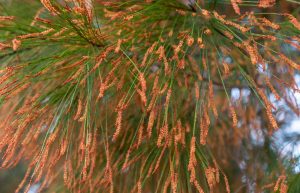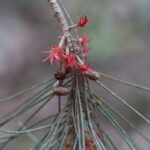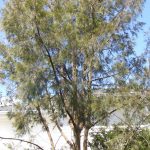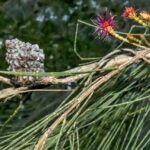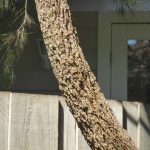This image by John Robert McPherson, has licence: CC BY-SA 4.0 <https://creativecommons.org/licenses/by-sa/4.0/>
Gardening with Indigenous Plants
Indigenous Plant Use
Identification & Control of Common Weeds
| Botanical Name: | Allocasuarina littoralis synonym: Casuarina littoralis |
| Common Name: | black she-oak, black sheoak, river black-oak |
| Sold As: | Tube ($2.00) |
| Plant Type(s): | Large Tree (over 6 m), Bird Attracting, Butterfly Attracting, Insect Attracting, Indigenous Plant Use |
| Indigenous Plant Use: | The gum can be chewed or made into a jelly by melting in hot water.CAUTION: Many plants are poisonous if not collected and prepared properly! |
| Growing Conditions: | Full Sun, Partial Shade
Well Drained |
| Size (HxW): | 8 m x 5 m |
| Foliage: | Leaves are reduced to rings of teeth along fine branchlets. Furrows along branchlets downy. 6-8 erect teeth, not overlapping. |
| Flowers: | Male flowers are dark brown, female are red. March-June. Dark brown male flower spikes 5-50 mm long at end of branchlets; female flowers stalkless, along side branches. Fruit cones to 3 cm, flattened on top. |
| General Comments: | Fast growing upright dark green tree with fissured bark. Windbreaks. Male plants are attractive in flower, fruit of female plants attract larger parrots and cockatoos. Trunks are excellent to hang epiphytic orchids. Trees are male or female. Birds like the seeds and the insects it attracts. Food plant for caterpillars. |
 Further Information: |
This image by John Robert McPherson, has licence: CC BY-SA 4.0 <https://creativecommons.org/licenses/by-sa/4.0/>

